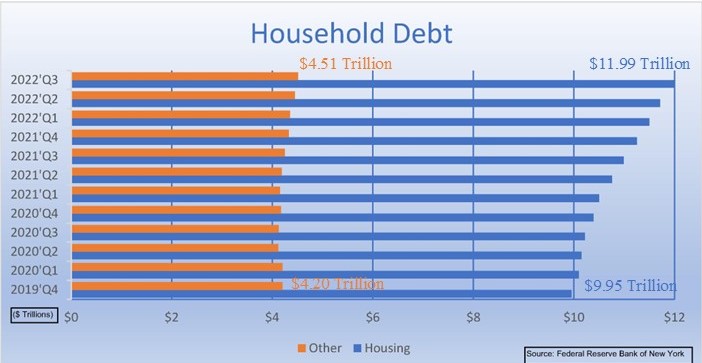According to WalletHub, the average credit card rate for new offers is now over 21%. Store Card rates are trending even higher, with some as high as 30%! Yet, after paying down credit cards during the worst of COVID, consumers are ramping up balances once again. At $930 billion, they are quickly approaching pre-pandemic levels.
Higher credit card payments have combined with elevated mortgage balances, raising household debt by 2.2% during the third quarter 2022. According to the Federal Reserve Bank New York (FRBNY), household debt totaled more than $16.5 trillion at September 30th.
Of that, $11.67 trillion was mortgage debt, which increased by $1 trillion year-over-year. Even Home Equity Lines (HELOCs), after years of decline, rose for the second consecutive quarter. This time by $3 billion bringing HELOC balances up to $322 billion.
Automobile loans, which have been heading up steadily for over a decade, stood at $1.524 trillion at the close of the third quarter while “other” loans posted increases of $25 billion and $21 billion over the second and third quarters, respectively. Combined, the third quarter saw non-housing balances increase by $66 billion.
So, while housing and auto loan originations are now stalling, household debt is still climbing. The graph breaks down household debt between mortgage debt and all other (below).
“Credit card balances saw a $38 billion increase since the second quarter, a 15% year-over-year increase marked the largest in more than 20 years”- FRBNY
Combined, household debt has increased by $2.35 billion (16.6%) since the end of 2019 (and the beginning of the pandemic). We know you, like us, are anxiously awaiting the date for year-end. For now, we are gleaning what we can from what comes out piecemeal.
For example, Synchrony Financial, CT, best known for its wide array of retail credit cards, and parent of 5-Star Synchrony Bank, UT, announced its fourth quarter results to shareholders on Monday, January 23rd. While its fourth quarter numbers are still quite good, loans 30 days or more past due climbed 103 basis points during calendar 2022—from 2.62% to 3.65%. Net charge-offs also increased from—2.37% to 3.48% over the years (111 basis points).
Making accommodations for higher net charge-offs, the company nearly doubled loan loss reserves. An additional $640 million was set aside, bringing loan loss reserves up to $1.2 billion. In spite of that, Synchrony has faith that the consumer is strong and resilient and it will not take a major hit to credit performance. We tend to agree with them.
The 51 banks listed on page 5 could have a different story to tell. These banks all reported that at least 5% of their consumer loans (including single family residential real estate) were 90 days or more delinquent at September 30, 2022. Synchrony Bank does NOT appear on this list. Even though it has witnessed an increase in past dues, its delinquent consumer loans were below 1.5% at September 30th, well below the 5% we used to produce this list.
As for the banks that DID make it onto page 5, you’ll see many are rated 5-Stars or 4-Stars and have very strong Bauer’s adjusted capital ratios. That’s an indicator that overall credit quality is good. So, while they are seeing the quality of consumer loans decline, the loan portfolios are diversified enough that they can withstand a hiccup on the consumer end.
Two of the banks have Bauer’s Adjusted CRs below 6%. They are 2-Star United Bank of Philadelphia, PA and 3-Star Banco Popular de Puerto Rico, PR. We will be particularly interested to see their 4th quarter numbers.
Banco Popular’s affiliate, 5-Star Popular Bank NY, was just fined $2.3 million by the Federal Reserve after self-reporting it had funded six PPP loans (totaling $1.1million) even after detecting significant indications of potential fraud. Popular gets kudos for self-reporting but not for waiting so long. The loans were approved and funded but the Small Business Administration (SBA) was not notified.


